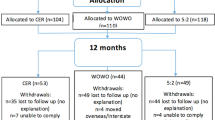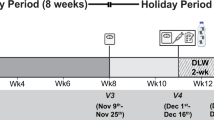Abstract
BACKGROUND/OBJECTIVES:
To examine associations among eating frequency, energy intake and body weight at baseline, as well as associations among change in eating frequency and change in energy intake and weight during a 12-week successful weight loss intervention in overweight and obese postpartum women.
SUBJECTS/METHODS:
Sixty-one Swedish women with pre-pregnancy body mass index of 25–35 kg/m2 completed a 4-day diet record at 10–14 weeks postpartum (baseline) and 12 weeks later (post-intervention), which were used to calculate energy intake and eating frequency, that is, the mean number of intake occasions per day.
RESULTS:
The women had a mean eating frequency of 5.9±1.2 intake occasions at baseline. A positive association was found between eating frequency and energy intake at baseline (β: 307±46 kcal, P<0.001), whereas no significant association between eating frequency and weight was observed (β: 2.3±1.2 kg, P=0.063). During the intervention period, reduced eating frequency was positively associated with energy intake reduction (β: 169±69 kcal, P=0.017) whereas no significant association was found with weight loss (β: 0.9±0.7 kg, P=0.179). Women receiving dietary intervention reduced their eating frequency more during the intervention period than did women not receiving dietary intervention (−1.0±0.7 vs −0.5±1.1, P=0.001).
CONCLUSIONS:
A positive association was found between eating frequency and energy intake at baseline and between reduced eating frequency and reduced energy intake during a 12-week weight loss intervention in overweight and obese postpartum women. Intervention studies on eating frequency are warranted to elucidate its effect on energy intake and weight among postpartum women.
This is a preview of subscription content, access via your institution
Access options
Subscribe to this journal
Receive 12 print issues and online access
$259.00 per year
only $21.58 per issue
Buy this article
- Purchase on Springer Link
- Instant access to full article PDF
Prices may be subject to local taxes which are calculated during checkout


Similar content being viewed by others
References
WHO. Preventing and managing the global epidemic. Report of a WHO consultation on obesity. WHO Tech Rep Ser 2000; 894: 1–253.
Sjöström LV . Mortality of severely obese subjects. Am J Clin Nutr 1992; 55: 516S–523SS.
The Swedish Council on Technology Assessment in Health Care. Report on Obesity: Problems and Interventions; A Systematic Review. Swedish Council on Technology Assessment in Health Care: Stockholm, 2002.
Gunderson EP, Abrams B . Epidemiology of gestational weight gain and body weight changes after pregnancy. Epidemiol Rev 2000; 22: 261–274.
Winkvist A, Rasmussen KM, Lissner L . Associations between reproduction and maternal body weight: examining the component parts of a full reproductive cycle. Eur J Clin Nutr 2003; 57: 114–127.
Gore SA, Brown DM, West DS . The role of postpartum weight retention in obesity among women: a review of the evidence. Ann Behav Med 2003; 26: 149–159.
Rössner S, Ohlin A . Pregnancy as a risk factor for obesity: lessons from the Stockholm Pregnancy and Weight Development Study. Obes Res 1995; 3 (Suppl 2), 267s–275s.
Cnattingius S, Bergström R, Lipworth L, Kramer MS . Prepregnancy weight and the risk of adverse pregnancy outcomes. N Engl J Med 1998; 338: 147–152.
Siega-Riz AM, Siega-Riz AM, Laraia B . The implications of maternal overweight and obesity on the course of pregnancy and birth outcomes. Matern Child Health J 2006; 10: S153–S156.
Baeten JM, Bukusi EA, Lambe M . Pregnancy complications and outcomes among overweight and obese nulliparous women. Am J Public Health 2001; 91: 436–440.
Gatenby SJ . Eating frequency: methodological and dietary aspects. Br J Nutr 1997; 77 (Suppl 1), S7–S20.
Bellisle F, McDevitt R, Prentice AM . Meal frequency and energy balance. Br J Nutr 1997; 77 (Suppl 1), S57–S70.
Bellisle F . Impact of the daily meal pattern on energy balance. Scand J Nutr 2004; 48 (3), 114–118.
Palmer MA, Capra S, Baines SK . Association between eating frequency, weight, and health. Nutr Rev 2009; 67: 379–390.
Gibney MJ, Wolever TM . Periodicity of eating and human health: present perspective and future directions. Br J Nutr 1997; 77 (Suppl 1), S3–S5.
McCrory MA, Howarth NC, Roberts SB, Huang TT . Eating frequency and energy regulation in free-living adults consuming self-selected diets. J Nutr 2011; 141: 148–153.
Fabry P, Hejl Z, Fodor J, Braun T, Zvolankova K . The frequency of meals. Its relation to overweight, hypercholesterolaemia, and decreased glucose-tolerance. Lancet 1964; 2: 614–615.
Metzner HL, Lamphiear DE, Wheeler NC, Larkin FA . The relationship between frequency of eating and adiposity in adult men and women in the Tecumseh Community Health Study. Am J Clin Nutr 1977; 30: 712–715.
Bertéus Forslund H, Torgerson JS, Sjöström L, Lindroos AK . Snacking frequency in relation to energy intake and food choices in obese men and women compared to a reference population. Int J Obes (Lond) 2005; 29: 711–719.
Bertéus Forslund H, Lindroos AK, Sjöström L, Lissner L . Meal patterns and obesity in Swedish women-a simple instrument describing usual meal types, frequency and temporal distribution. Eur J Clin Nutr 2002; 56: 740–747.
Howarth NC, Huang TT, Roberts SB, Lin BH, McCrory MA . Eating patterns and dietary composition in relation to BMI in younger and older adults. Int J Obes (Lond) 2007; 31: 675–684.
Drummond SE, Crombie NE, Cursiter MC, Kirk TR . Evidence that eating frequency is inversely related to body weight status in male, but not female, non-obese adults reporting valid dietary intakes. Int J Obes Relat Metab Disord 1998; 22: 105–112.
Basdevant A, Craplet C, Guy-Grand B . Snacking patterns in obese French women. Appetite 1993; 21: 17–23.
Ohlin A, Rössner S . Factors related to body weight changes during and after pregnancy: the Stockholm Pregnancy and Weight Development Study. Obes Res 1996; 4: 271–276.
Bertz F, Brekke HK, Ellegård L, Rasmussen KM, Wennergren M, Winkvist A . Diet and exercise weight-loss trial in lactating overweight and obese women. Am J Clin Nutr 2012; 96: 698–705.
de Castro JM, McCormick J, Pedersen M, Kreitzman SN . Spontaneous human meal patterns are related to preprandial factors regardless of natural environmental constraints. Physiol Behav 1986; 38: 25–29.
Bachman JL, Raynor HA . Effects of manipulating eating frequency during a behavioral weight loss intervention: a pilot randomized controlled trial. Obesity (Silver Spring) 2012; 20: 985–992.
Tong IS, Lu Y . Identification of confounders in the assessment of the relationship between lead exposure and child development. Ann Epidemiol 2001; 11: 38–45.
Butte NF, King JC . Energy requirements during pregnancy and lactation. Public Health Nutr 2005; 8: 1010–1027.
Farshchi HR, Taylor MA, Macdonald IA . Beneficial metabolic effects of regular meal frequency on dietary thermogenesis, insulin sensitivity, and fasting lipid profiles in healthy obese women. Am J Clin Nutr 2005; 81: 16–24.
Berteus Forslund H, Klingström S, Hagberg H, Löndahl M, Torgerson JS, Lindroos AK . Should snacks be recommended in obesity treatment? A 1-year randomized clinical trial. Eur J Clin Nutr 2008; 62: 1308–1317.
Poppitt SD, Swann D, Black AE, Prentice AM . Assessment of selective under-reporting of food intake by both obese and non-obese women in a metabolic facility. Int J Obes Relat Metab Disord 1998; 22: 303–311.
Kirk TR . Role of dietary carbohydrate and frequent eating in body-weight control. Proc Nutr Soc 2000; 59: 349–358.
Forsum E, Kabir N, Sadurskis A, Westerterp K . Total energy expenditure of healthy Swedish women during pregnancy and lactation. Am J Clin Nutr 1992; 56: 334–342.
Lawton CL, Delargy HJ, Smith FC, Hamilton V, Blundell JE . A medium-term intervention study on the impact of high- and low-fat snacks varying in sweetness and fat content: large shifts in daily fat intake but good compensation for daily energy intake. Br J Nutr 1998; 80: 149–161.
Bellisle F, Dalix AM, Mennen L, Galan P, Hercberg S, de Castro JM et al. Contribution of snacks and meals in the diet of French adults: a diet-diary study. Physiol Behav 2003; 79: 183–189.
Viskaal-van Dongen M, Kok FJ, de Graaf C . Effects of snack consumption for 8 weeks on energy intake and body weight. Int J Obes (Lond) 2010; 34: 319–326.
Schusdziarra V, Hausmann M, Wittke C, Mittermeier J, Kellner M, Wagenpfeil S et al. Contribution of energy density and food quantity to short-term fluctuations of energy intake in normal weight and obese subjects. Eur J Nutr 2010; 49: 37–43.
Booth DA . Mechanisms from models—actual effects from real life: the zero-calorie drink-break option. Appetite 1988; 11 (Suppl 1), 94–102.
Marmonier C, Chapelot D, Fantino M, Louis-Sylvestre J . Snacks consumed in a nonhungry state have poor satiating efficiency: influence of snack composition on substrate utilization and hunger. Am J Clin Nutr 2002; 76: 518–528.
Popkin BM, Duffey KJ . Does hunger and satiety drive eating anymore? Increasing eating occasions and decreasing time between eating occasions in the United States. Am J Clin Nutr 2010; 91: 1342–1347.
Piernas C, Popkin BM . Snacking increased among U.S. adults between 1977 and 2006. J Nutr 2010; 140: 325–332.
Acknowledgements
AW, HKB and FB conceived and conducted the research in the LEVA-trial; EH analyzed the data; EH, HKB, AW, FB and HBF interpreted the results and wrote the manuscript. We thank Anna Carin Hagstig, Elisabeth Gramatkovski and the women who participated in the LEVA-trial for their contribution to the development and execution of this research. The study was supported by grants from the Swedish Research Council (K2009–70X-21091–01–03) and the Swedish Council for Working Life and Social Research (2006–0339).
Author information
Authors and Affiliations
Corresponding author
Ethics declarations
Competing interests
The authors declare no conflict of interest.
Rights and permissions
About this article
Cite this article
Huseinovic, E., Winkvist, A., Bertz, F. et al. Eating frequency, energy intake and body weight during a successful weight loss trial in overweight and obese postpartum women. Eur J Clin Nutr 68, 71–76 (2014). https://doi.org/10.1038/ejcn.2013.200
Received:
Revised:
Accepted:
Published:
Issue Date:
DOI: https://doi.org/10.1038/ejcn.2013.200
Keywords
This article is cited by
-
The effects of eating frequency on changes in body composition and cardiometabolic health in adults: a systematic review with meta-analysis of randomized trials
International Journal of Behavioral Nutrition and Physical Activity (2023)
-
Relationship between diet-related indicators and overweight and obesity in older adults in rural Japan
The Journal of nutrition, health and aging (2017)
-
Evening chronotype associates with obesity in severely obese subjects: interaction with CLOCK 3111T/C
International Journal of Obesity (2016)



